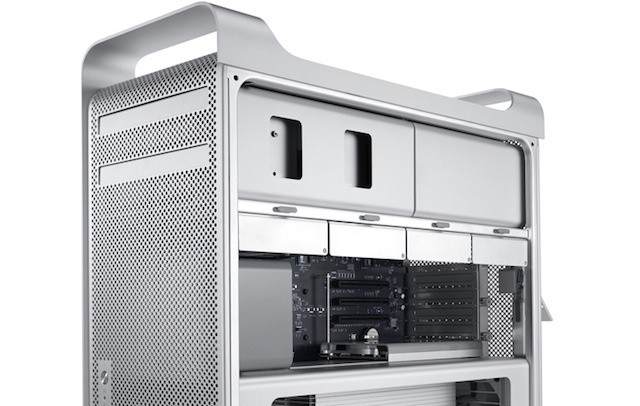Apple quietly updated its Mac Pro line last week. The update was an important move even though the actual changes were so minor as to be barely noteworthy. The minor refresh gave high computing customers a sense of confidence that Apple wasn’t going to abandon the Mac Pro line anytime soon. That sense of confidence got a boost from New York Times columnist David Pogue, who was assured more substantive Mac Pro upgrades were in the works for 2013.
The Mac Pro is something of a relic when it comes to Apple’s current strategy. It’s the only Mac that features significant expansion options using industry standard hardware – a point made by Lifehacker columnist Adam Dachis, who compared the Mac Pro’s specs and costs to three hackintosh options. Looking at the Mac Pro as simply a series of specs, performance, and cost is appropriate for most users – but not for some important niche markets.
The overall argument is that you can create a PC with equivalent hardware and reasonably comparable performance that is capable of running OS X for much less than you’d pay Apple for a Mac Pro. Even the areas where Apple offers hardware combinations that aren’t easily replicated — such as in motherboard designs that accommodate a greater range of multi-core processors — Dachis makes a solid argument that such systems can still deliver comparable performance at a much lower cost.
That’s an argument that is difficult to refute. After all how many Mac users truly need 12 cores in a single system? In the same vein, how many Mac users are going to slap anything near 64 GB of memory (the maximum that the Mac Pro can handle) into a system?
The answer is almost no one. No matter how demanding the most advanced user is, he or she isn’t going to need that kind of processing power or memory. That doesn’t mean, however, that the capability is unimportant.
The Mac Pro is largely seen as the ideal Mac for media work. It’s a standard work station for design professionals, photographers, and professional video editors. For those users, Apple’s decision to make a minor update, rather than a redesign that includes features like USB 3 and Thunderbolt, is problematic. The current offering doesn’t move the Mac Pro as a professional workstation forward. If a major redesign is in the works, it will almost certainly address these needs.
Beyond that market, however, Apple has hyped OS X and the Mac Pro as solutions for large-scale computing clusters and scientific computing. Similarly, the Mac Pro serves an important niche in its role as Apple’s primary SAN and metadata controller option. It is also the most powerful Mac hardware to run OS X Server on the market. In situations like these, sheer computational ability — the ability to support up to 12 cores and 64GB of RAM — are the crucial complements that the Mac Pro brings to the table.
Will most Mac users use the Mac Pro in these way? No. Could many Mac users build a hackintosh equivalent and have it be functional? Yes. If you’re an organization purchasing Mac Pros specifically because of those unique options, should you go with an unsupported hardware and OS combination, like a hackintosh? Absolutely not.
The Mac Pro has never been a machine for every Mac user. With the demise of the Xserve, the Mac Pro serves as a high-end and very configurable Mac, a high-computing solution, and a server. Most users won’t push it to its limits, but for those users or organizations that do, it’s crucial part of Apple’s lineup.


